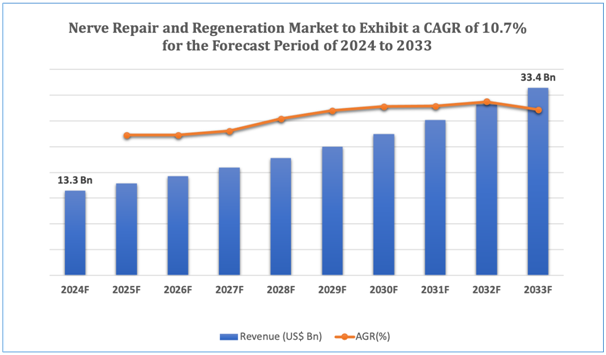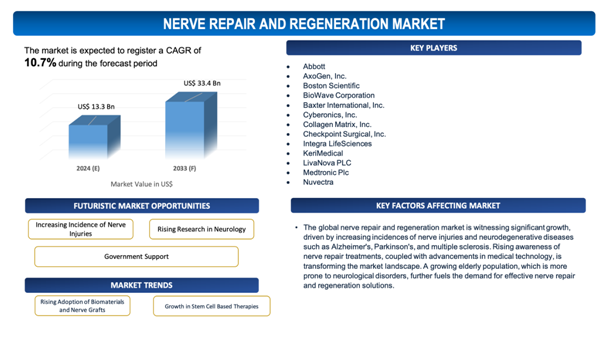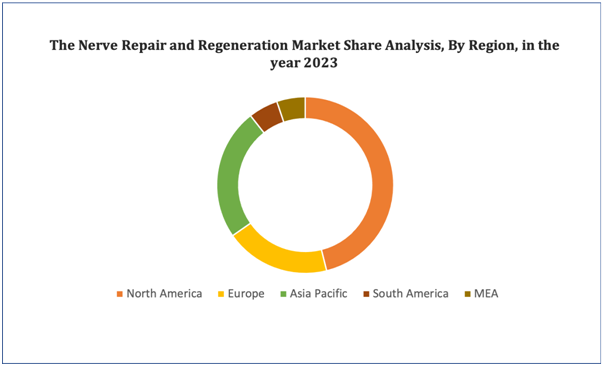Nerve Repair and RegenerationMarket Overview
The global nerve repair and regeneration market is estimated to be worth over USD 33.4 Bn in 2033 and is expected to grow at CAGR of 10.7% during the forecast period (2024-2033).
Nerve repair and regeneration are rapidly advancing fields in healthcare that focus on restoring nerve function lost due to injury, trauma, or neurodegenerative diseases. The nervous system is critical for transmitting signals between different parts of the body, and any damage can lead to severe impairments in movement, sensation, or organ function. Traditional treatments for nerve damage have typically relied on physical therapy, surgical interventions, or medications to manage symptoms. However, recent developments in nerve repair and regeneration are transforming this landscape, offering more promising solutions for patients.
Innovations in this field primarily revolve around advanced techniques such as stem cell therapy, bioengineered scaffolds, and gene therapy. Stem cell therapy is being explored to promote nerve regeneration by replacing damaged cells with healthy ones that can facilitate healing. Bioengineered scaffolds, often made from biodegradable materials, act as a physical bridge for nerve fibers to grow, guiding and supporting the natural regeneration process. These scaffolds can be implanted at the injury site to promote nerve growth and restore functionality. Gene therapy, on the other hand, aims to manipulate genetic material within cells to stimulate nerve growth or inhibit the factors that prevent regeneration.
Another significant development in nerve repair is the use of electrical stimulation, which involves sending controlled electrical impulses to injured nerves to encourage regrowth. This technology has shown promise in promoting faster recovery and improving the outcome of nerve repair procedures. Additionally, neurotrophic factors—molecules that support the growth, survival, and differentiation of neurons—are being researched to enhance the body’s natural healing processes.
The implications of these advancements are vast, transforming the treatment of nerve injuries caused by conditions such as spinal cord injuries, peripheral nerve injuries, stroke, and neurodegenerative disorders like Parkinson's disease and amyotrophic lateral sclerosis (ALS). As these technologies continue to evolve, they are expected to significantly improve the quality of life for individuals suffering from nerve damage by enabling faster recovery, reducing complications, and potentially restoring full nerve function. The integration of biotechnology, material science, and regenerative medicine holds immense potential for the future of nerve repair and regeneration.
Figure 1. Nerve Repair and Regeneration: Market Size

Get more details on this report - Request Free Sample
Key Market Insights
The global nerve repair and regeneration market is witnessing significant growth, driven by increasing incidences of nerve injuries and neurodegenerative diseases such as Alzheimer's, Parkinson's, and multiple sclerosis. Rising awareness of nerve repair treatments, coupled with advancements in medical technology, is transforming the market landscape. A growing elderly population, which is more prone to neurological disorders, further fuels the demand for effective nerve repair and regeneration solutions.
Key developments in the market include the use of bioengineered nerve conduits, nerve grafts, and neurostimulation devices. Bioengineered nerve conduits, designed to bridge gaps in damaged nerves, are increasingly being used in clinical settings. The rise of stem cell therapy is another notable innovation, as it holds the potential to regenerate damaged nerve tissues by introducing healthy cells into the body. Researchers are also exploring gene therapy and advanced neurostimulation techniques to improve treatment outcomes for patients with severe nerve damage.
Novel technologies such as 3D printing and biomaterials are being integrated into the development of nerve conduits and scaffolds, providing more personalized and effective treatments. These innovations are particularly impactful for peripheral nerve injuries and spinal cord repair. Additionally, neurostimulation devices like deep brain stimulators are playing a crucial role in treating neurodegenerative conditions, offering improved quality of life for patients.
The market is anticipated to soarsignificantly as research in nerve repair techniques continues to progress, paving the way for more advanced and effective therapies for nerve damage and degeneration.
Market Dynamics
Market Drivers
Increasing Prevalence of Nerve Injuries
The soaring incidence of nerve injuries is a primary driver for the global nerve repair and regeneration market. Nerve injuries can result from trauma, accidents, surgical procedures, or medical conditions such as diabetes, all of which are becoming more prevalent. As the global population ages and lifestyles become more susceptible to injuries through road accidents, sports-related activities, and work-related incidents, the demand for effective treatments for nerve damage continues to grow. Peripheral nerve injuries, in particular, are common in traumatic cases and often results in debilitating conditions like loss of sensory or motor functions.
This increasing need for advanced medical interventions has spurred innovation in nerve repair and regeneration technologies. Healthcare providers are emphasizing on developing bioengineered conduits, nerve grafts, and neurostimulation techniques to restore nerve function. In addition, neurodegenerative diseases such as Alzheimer's, Parkinson's, and multiple sclerosis are contributing to the rising demand for nerve regeneration therapies.
As nerve injuries increasingly affect a broad segment of the population, the nerve repair and regeneration market is estimated to experience continued growth, fuelled by the consistent need for advanced treatment options to address nerve-related complications effectively.
Market Restraints
With regard to numerous advantages of Nerve Repair and Regeneration, the market faces several challenges due to the unique characteristics and requirements associated with these potent pharmaceutical products. Some of the key market challenges include:
- High Cost of Treatment and Procedures: Nerve repair and regeneration therapies, including surgeries, grafts, and neurostimulation devices, are often expensive, making them inaccessible to a large portion of the population, especially in low- and middle-income countries. The high cost can deter the adoption of advanced nerve repair solutions.
- Limited Availability of Skilled Professionals: The complex nature of nerve repair and regeneration procedures requires highly trained and specialized healthcare professionals. A shortage of such expertise in certain regions can hinder the growth of the market, as it may lead to delays in treatment or suboptimal patient outcomes.

Get more details on this report - Request Free Sample
Market Opportunity
Growing Research in Neurology
As advancements in neuroscience continue to deepen the understanding of nerve function, injury, and repair mechanisms, innovative treatments and technologies are being developed to address nerve damage more effectively. Research initiatives are focusing on regenerative medicine, stem cell therapies, gene editing, and bioengineered scaffolds, all of which have the potential to revolutionize the treatment of nerve injuries and neurodegenerative diseases.
This surge in neurology research is fuelled by the growing prevalence of conditions like Alzheimer's, Parkinson's, spinal cord injuries, and peripheral nerve injuries, which demand advanced therapeutic solutions. Alongside, collaboration between academic institutions, research centres, and biotech companies is accelerating the discovery and commercialization of novel regenerative techniques.
As more breakthroughs emerge from continuous research, the global nerve repair and regeneration market stands to benefit from the growing demand for innovative, effective therapies. This creates a fertile ground for investment and development in new treatment modalities, ultimately expanding the market's scope and accessibility to leading-edge solutions.
Market Trends
- Rising Adoption of Biomaterials and Nerve Grafts: The use of biomaterials, such as synthetic and biological nerve grafts, is gaining traction due to their ability to promote nerve regeneration and provide structural support. These materials are increasingly being integrated into nerve repair procedures, offering enhanced outcomes for patients with severe nerve damage.
- Growth in Stem Cell-Based Therapies: Stem cell therapies are emerging as a promising treatment alternative in nerve repair and regeneration. Research into the use of stem cells, including mesenchymal stem cells (MSCs) and neural stem cells, is advancing swiftly, as they have shown potential to restore damaged nerves and improve functional recovery in patients with neurodegenerative conditions and traumatic injuries.
Nerve Repair and Regeneration Market: Key Segments
By Product
- Neurostimulation
- Neuromodulation Devices
- Biomaterials
By Indication
- Failed Back Surgery Syndrome
- Parkinson's Disease
- Urinary Incontinence
- Epilepsy
- Gastroparesis, Nerve Repair
- Grafting
By Application
- Neurostimulation
- Neuromodulation Surgeries
- Neurorrhaphy
- Nerve Grafting
- Stem Cell Therapy
By End User
- Hospitals and Clinics
- Ambulatory Surgical Centres
By Key Geographical Regions
- North America
- Europe
- Asia-Pacific
- Middle East and Africa
- South America
Figure 4. Nerve Repair and Regeneration Market: Distribution by Region

Get more details on this report - Request Free Sample
Nerve Repair and Regeneration Market: Regional Analysis
North America dominates the nerve regeneration and repair market because of the well-developed healthcare industry and presence of leading medical diagnostics manufacturers within the region.
Asia-Pacific (APAC) is expected to witness significant growth during the forecast period of 2022 to 2029 due to the increase in number of patients suffering from chronic diseases in the region.
Leading Nerve Repair and Regeneration Developers
Industry Trends and Global Forecasts, 2023-2035 report features an extensive study of the current market landscape, market size and future opportunities associated with the Nerve Repair and Regenerationmarket, during the given forecast period. Further, the market report highlights the efforts of several stakeholders engaged in this rapidly emerging segment of the biopharmaceutical industry. Key takeaways of the Nerve Repair and Regenerationmarket are briefly discussed below.
The report includes the list of players operating in the global Nerve Repair and Regenerationmarket. Some of the key players include:
- Abbott
- AxoGen, Inc.
- Boston Scientific
- BioWave Corporation
- Baxter International, Inc.
- Cyberonics, Inc.
- Collagen Matrix, Inc.
- Checkpoint Surgical, Inc.
- Integra LifeSciences
- KeriMedical
- LivaNova PLC
- Medtronic Plc
- Nuvectra
- Nevro Corp
- NeuroPace, Inc.
- NeuroSigma
- OrthoMed, Inc.
- Polyganics
- Stryker
- Synovis Micro Companies Alliance, Inc.
- Soterix Medical, Inc.
- Synapse Biomedical, Inc.
Nerve Repair and Regeneration Market: Key Developments
- In September 2024, Axogen, Inc.,a global leader in developing and marketing innovative surgical solutions for peripheral nerve injuries, announced that it has completed the rolling submission process for its Biologics License Application (BLA) to the U.S. Food and Drug Administration (FDA) for Avance Nerve Graft®.
Scope of the Report
The market report presents an in-depth analysis of the various firms / organizations that are engaged in this market, across different segments, as defined in the below table:
|
|
Key Report Attributes |
Details |
||
|
|
Base Year |
2023 |
||
|
|
Forecast Period |
2024-2033 |
||
|
|
CAGR (2024-2033) |
10.7% |
||
|
|
Product |
|
||
|
|
Indication |
|
||
|
|
Application |
|
||
|
|
End User |
|
||
|
|
Key Geographical Regions |
|
||
|
Key Companies Profiled |
|
|
||
